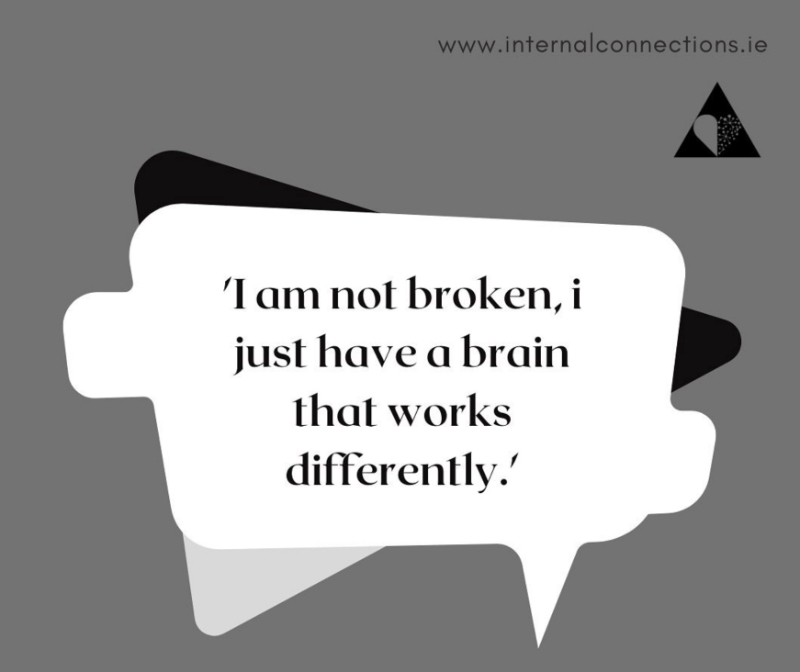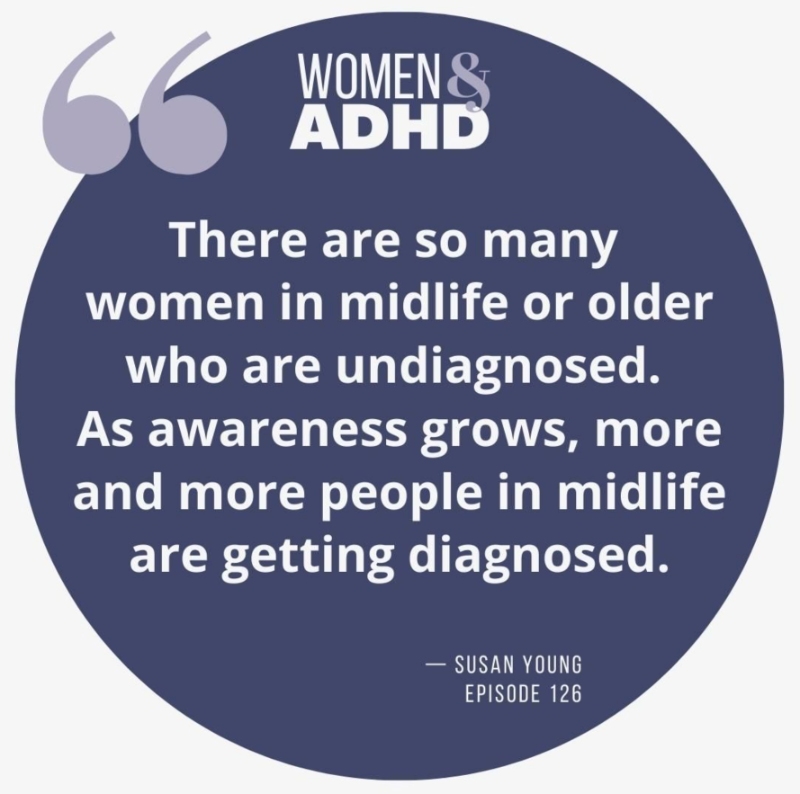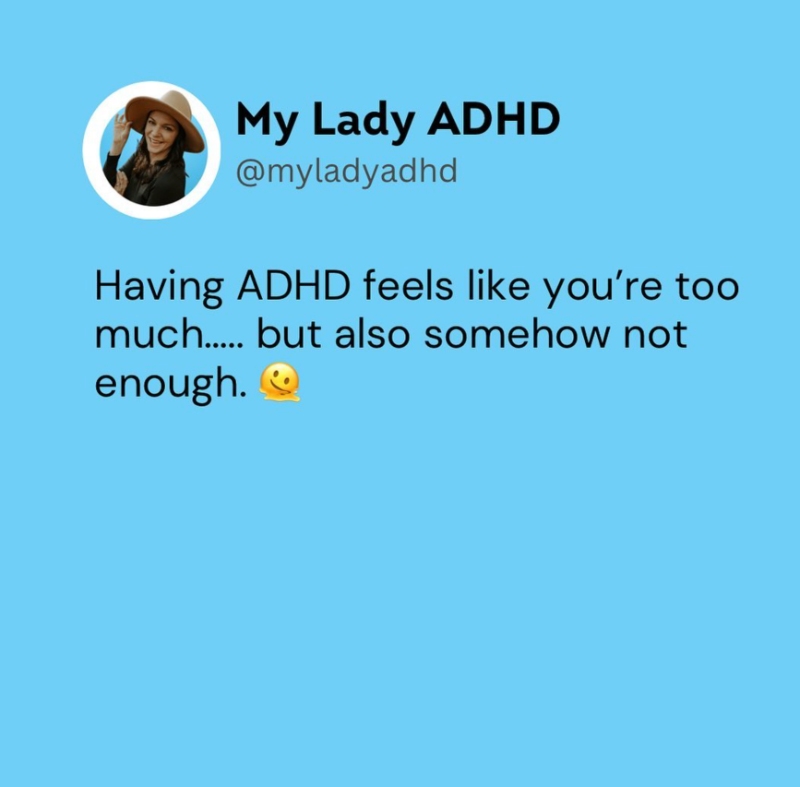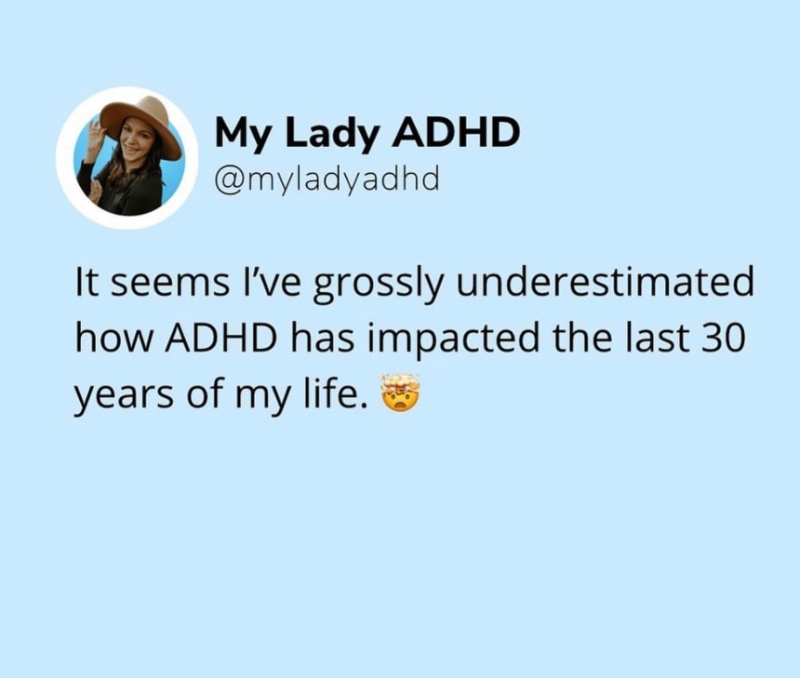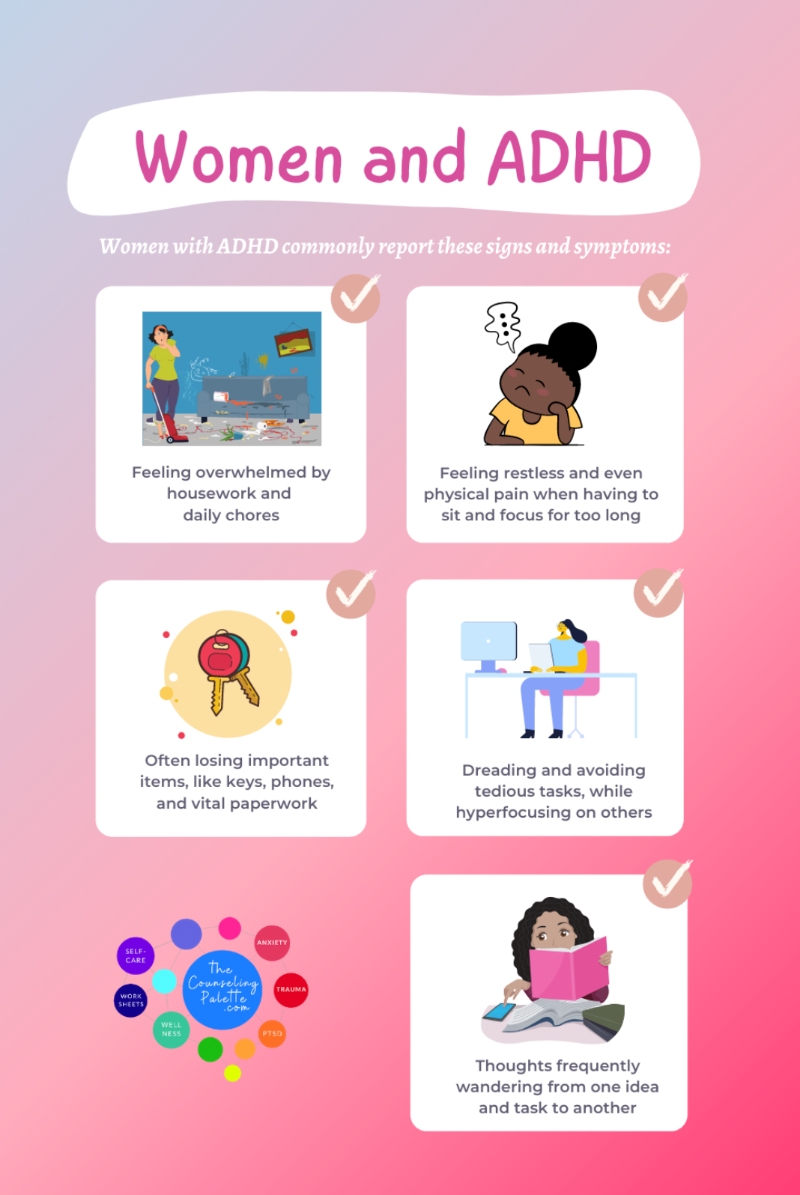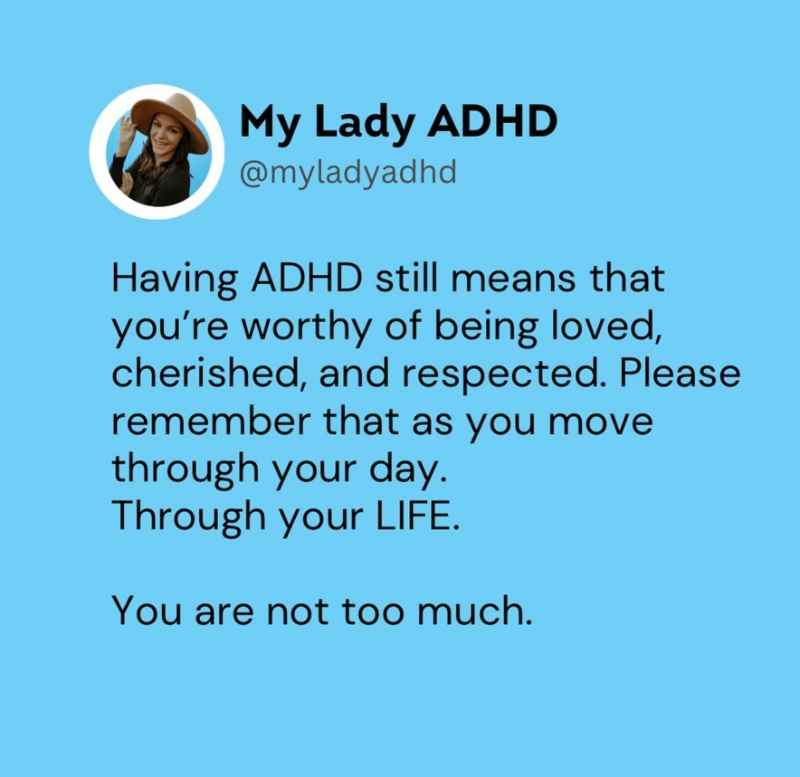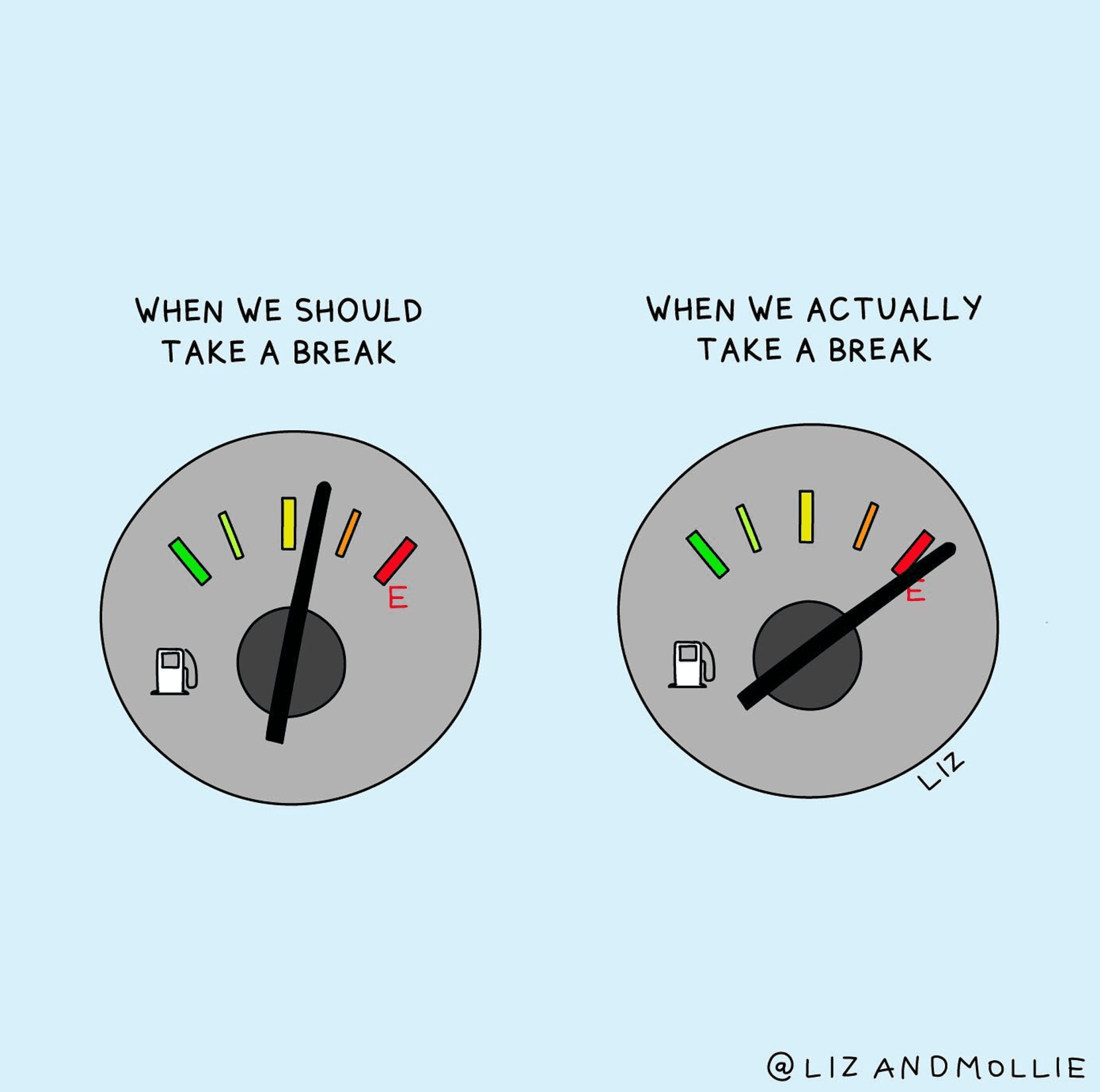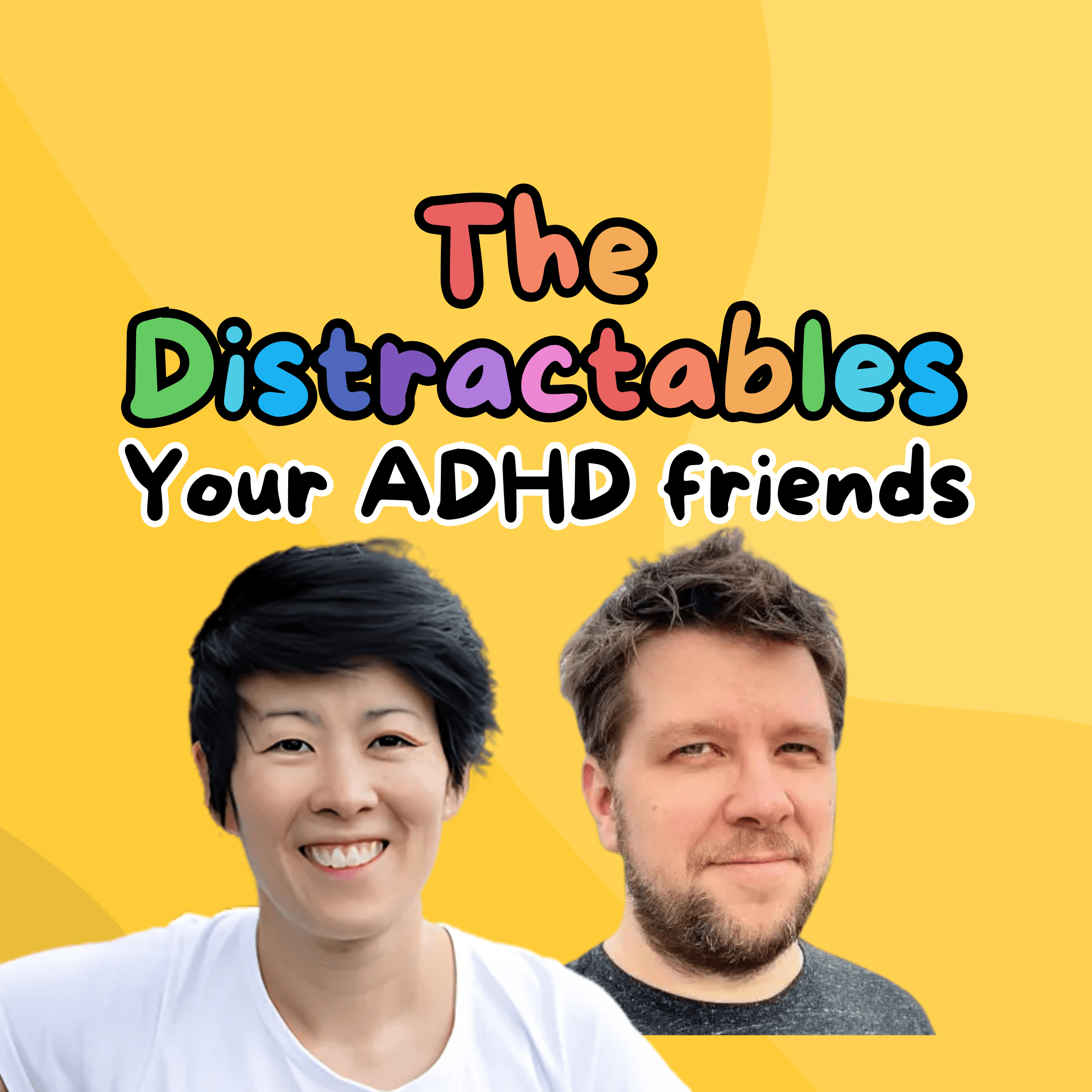Perhaps your best friend, colleague, or aunt has been feeling down about themselves lately... maybe they had forgotten to pay a bill, or were late to a meeting, and are now beating themselves up for being unorganized or unreliable. They may even start to believe the negative comments from those around them who accuse them of being careless, forgetful, or aloof...
What they don't realize is that their struggles may stem from undiagnosed inattentive ADHD symptoms. Many women and girls go undiagnosed, not realizing that their symptoms are not character flaws, but a condition that can be treated with appropriate strategies.
Source: Internal Connections
In this article, we will explore the impact of inattentive ADHD on women and girls, as well as some strategies for managing the condition beyond medication.
TL;DR situation? Scroll to the bottom for a summary.
Source: Women and ADHD podcast
What is ADHD?
Attention-Deficit Hyperactivity Disorder, commonly known as ADHD, is a neurodevelopmental disorder that affects both children and adults. It is characterized by a persistent pattern of inattention and/or hyperactivity-impulsivity that interferes with daily functioning and development.
People with ADHD may struggle to focus on tasks, sustain attention, organize activities, and control impulses, which can impact academic, occupational, and social performance.
While ADHD is often associated with children, many adults also experience the symptoms, and women with inattentive ADHD may face unique challenges due to the tendency for their symptoms to go unnoticed, or be misdiagnosed.
The 3 types of ADHD : Inattentive, Hyperactive-implusive, and Combined type
Did you know that there are three main types of ADHD? 🤔
The 3 types are primarily categorized by the type of symptoms that are most prominent:
Predominantly inattentive type: Also known as ADD (Attention Deficit Disorder), this type of ADHD is characterized by a primary symptom of inattention. People with this type of ADHD may struggle to sustain attention, forget details, lose things frequently, and have difficulty following through on instructions or completing tasks.
But, what does this often look like? Imagine a woman who frequently forgets appointments and deadlines, loses track of time, and has difficulty completing tasks on time. She may have trouble paying attention to details, often overlook important information, and struggle to organize her thoughts and belongings. This type of ADHD can be particularly challenging for women as the symptoms may not be as obvious as the hyperactive-impulsive type, and may be misinterpreted as laziness, lack of motivation, or disorganization. It can impact various areas of life, such as work, school, and personal relationships, and lead to feelings of frustration, anxiety, and depression.
Predominantly hyperactive-impulsive type: This type of ADHD is characterized by a primary symptom of hyperactivity and impulsivity. People with this type of ADHD may be fidgety, restless, talkative, and have difficulty waiting their turn or controlling impulses. This type is what most commonly comes to mind when people think of ADHD.
But, what does this often look like? Imagine a child in a classroom who frequently interrupts the teacher and classmates, blurts out answers before the questions are finished, and has difficulty waiting for their turn. They may also fidget in their seat, squirm or tap their feet, and have difficulty sitting still for extended periods of time.
Combined type: This type of ADHD is a combination of both inattentive and hyperactive-impulsive symptoms, with both sets of symptoms being equally present.
What does this often look like? Imagine a teenager who struggles with both inattention and hyperactivity-impulsivity, they have difficulty focusing on their schoolwork, often daydreaming during lectures and forgetting to complete assignments. At the same time, they may have trouble sitting still, fidgeting or tapping their feet constantly, and blurting out answers during class. They may also struggle with impulse control, engaging in risky behaviors such as driving recklessly or experimenting with drugs.
It's important to note that while these are the primary types of ADHD, each individual's experience of ADHD can vary in terms of the severity and combination of symptoms. Additionally, there are different subtypes and presentations of ADHD that can be diagnosed based on specific criteria outlined in the DSM-5 (Diagnostic and Statistical Manual of Mental Disorders, 5th edition).
Inattentive ADHD symptoms and traits
So you've now read through the three different types, and feel that the inattentive-type ADHD may be what you're experiencing? Or that it sounds like someone you're close to? Let's explore further.
Some further symptoms and traits of inattentive ADHD include:
Difficulty focusing or paying attention: Individuals with inattentive ADHD often have difficulty sustaining attention or focusing on tasks, especially those that are repetitive or require sustained effort. They may be easily distracted by external stimuli or internal thoughts and daydreams.
Poor organization and time management: People with inattentive ADHD may have difficulty with organization and time management, often struggling to plan ahead, keep track of schedules, or prioritize tasks. They may also be forgetful and have trouble remembering appointments, deadlines, or important details.
Hyperfixation and/or hyperfocus: Women with inattentive ADHD may experience an intense interest in a particular thing- whether it be a specific topic, hobby, activity, food, or even clothes, that can endure for a few days, weeks, months, or even years.
Forgetfulness: Individuals with inattentive ADHD may be forgetful, often losing or misplacing objects, forgetting important information, or failing to complete tasks that they have started.
Lack of motivation or drive: People with inattentive ADHD may appear unmotivated or disinterested in tasks that do not capture their attention or interest. They may struggle to initiate or complete tasks that they find boring or unengaging.
Avoidance of mental effort: Individuals with inattentive ADHD may avoid mental effort, such as reading long texts, doing complex math problems, or engaging in deep thought. They may find it difficult to sustain effort over time, leading to procrastination or incomplete work.
Indecision: Having many options may be overhwhelming, and women with inattentive ADHD may experience ADHD paralysis
Slowness or sluggishness: People with inattentive ADHD may appear slow or sluggish in their movements and thinking. They may have difficulty processing information quickly, leading to slower response times or difficulty keeping up with fast-paced conversations.
Shyness or social anxiety: Some individuals with inattentive ADHD may experience shyness or social anxiety, which can be exacerbated by difficulty focusing and paying attention in social situations.
It's important to remember that not all individuals with inattentive ADHD will exhibit all of these traits, and that each person's experience of ADHD can vary. Additionally, many of these traits can also be present in individuals without ADHD, so a proper diagnosis should be made by a qualified healthcare professional.
Inattentive ADHD is more prevalent in women
About 13% of men are diagnosed with ADHD during their lifetime, with just 4.2% of women being diagnosed. However, research suggests that inattentive ADHD is more prevalent in women than in men, with some estimates suggesting that it affects two to three times as many women as men.
There are several factors that may contribute to this gender disparity.
Why is inattentive ADHD in women and girls so frequently missed and misdiagnosed?
First, inattentive ADHD is often less noticeable than hyperactive-impulsive ADHD, as women and girls with inattentive ADHD tend to be less disruptive and more internalizing in their symptoms. As a result, many women and girls with inattentive ADHD may go undiagnosed or misdiagnosed for years, which can lead to increased frustration, anxiety, and negative impacts on their quality of life.
Also, the diagnostic criteria for ADHD are based on studies conducted primarily on male participants, which may result in a male-biased perspective on the disorder. This can lead to healthcare providers overlooking or underestimating the prevalence and severity of ADHD symptoms in women. This has also led to women and girls inattentive ADHD to be under-diagnosed, misdiagnosed, and under-treated.
Additionally, social and cultural factors may play a role, as women are often expected to be more organized, detail-oriented, and responsible for managing household and caregiving responsibilities, which can exacerbate symptoms of inattentive ADHD.
Finally, hormonal factors may also play a role, as estrogen levels can affect dopamine and norepinephrine levels in the brain, which are neurotransmitters that play a role in attention and focus.
While more research is needed to fully understand the gender differences in ADHD, it is important for healthcare providers to recognize and address these disparities to ensure that women with inattentive ADHD receive appropriate diagnosis and treatment.
Source: National Library of Medicine
What can undiagnosed inattentive ADHD in women be misdiagnosed as?
Undiagnosed inattentive ADHD in women can often be misdiagnosed as anxiety disorder or depression. This is because many of the symptoms of inattentive ADHD overlap with those of anxiety and depression, such as difficulty concentrating, low motivation, and feelings of sadness or hopelessness. As a result, women with inattentive ADHD may be prescribed antidepressants or anti-anxiety medication without addressing the underlying issue.
In addition, women with inattentive ADHD may also be misdiagnosed with other conditions such as bipolar disorder or borderline personality disorder, due to their mood swings and emotional dysregulation. It's important for healthcare providers to consider a range of possible diagnoses and conduct a thorough evaluation before making any conclusions or recommendations for treatment.
Inattentive ADHD diagnosis stories
We hear from many community members who have been diagnosed with inattentive ADHD later in life. Their stories are all unique, however, often have similar events that help lead them to having an accurate diagnosis:
As adults seeking a diagnosis: Many women with inattentive ADHD are not diagnosed until adulthood, often when they begin to struggle with the demands of work and family life. They may have a history of struggling in school, but were not diagnosed as children due to their quiet, daydreaming nature and lack of disruptive behavior.
After their child is diagnosed: Sometimes women are diagnosed with inattentive ADHD after their child is diagnosed and they recognize similar traits in themselves. Seeing their child's symptoms can lead to self-reflection and seeking help from health care professionals for their own struggles.
During major life transitions: Major life transitions such as starting college, a new job, or becoming a parent can be triggering for women with inattentive ADHD, and can lead to a diagnosis. The increased demands and responsibilities can exacerbate symptoms and lead to seeking help.
After experiencing depression or anxiety: Women with inattentive ADHD may be misdiagnosed with anxiety or depression before receiving a proper diagnosis. Their struggles with inattention and lack of focus can cause feelings of anxiety and inadequacy, leading to seeking help for those symptoms.
As part of a dual diagnosis: Inattentive ADHD is often seen alongside other mental health conditions such as anxiety or depression. Women with other conditions may also struggle with inattention and lack of focus, leading to a dual diagnosis.
Source: My Lady ADHD
Late diagnosis of inattentive ADHD in women
The late diagnosis of inattentive ADHD for women can bring up a wide range of emotions, including:
- Relief: For some women, receiving a diagnosis of inattentive ADHD can be a relief. It can explain the challenges they have faced throughout their lives and validate their experiences. It can also provide them with a path towards effective treatment and strategies for managing their symptoms.
- Anger: Women may feel anger and frustration that they were not diagnosed earlier. They may feel that their struggles could have been prevented or lessened with earlier intervention. Additionally, they may feel that their experiences were dismissed or overlooked by medical professionals, teachers, or loved ones.
- Sadness: Women may feel sadness and grief for the opportunities they missed or the relationships that suffered as a result of their undiagnosed ADHD. They may also feel a sense of loss for the time and energy they spent trying to cope with their symptoms throughout their entire life without understanding the root cause.
- Validation: Receiving a diagnosis of inattentive ADHD can provide women with a sense of validation for their experiences. It can help them understand that their struggles were not their fault and that they are not alone in their challenges.
- Hope: A late diagnosis in adult women can also provide them with hope for the future. With proper treatment and support, they can learn strategies to manage their symptoms and live a more fulfilling life. They may also feel a sense of hope for their children or other family members who may also have undiagnosed ADHD.
Source: My Lady ADHD
How does inattentive ADHD in women impact daily life?
Inattentive ADHD in women can have a significant impact on daily life, including difficulties with work, relationships, and self-esteem. Women with inattentive ADHD may struggle with completing tasks, maintaining focus, and staying organized, which can lead to frustration and feelings of inadequacy.
These difficulties may also affect relationships with friends and family, as well as job performance and career prospects. Here are some common ways inattentive ADHD can impact women's daily lives:
Difficulty staying organized: Women with inattentive ADHD may have difficulty staying organized, which can impact their ability to manage their time, stay on top of daily tasks, keep track of appointments, and complete tasks on time.
Forgetfulness: Inattentive ADHD can cause forgetfulness, which may lead to missed appointments or deadlines (such as doctor appointments), forgotten tasks (bills to pay), and lost or misplaced items (such as keys, their mobiles).
Poor time management: Women with inattentive ADHD may struggle with time management, leading to difficulty completing tasks on time, procrastination, and a tendency to underestimate how long tasks will take (time blindness).
Lack of focus: Inattentive ADHD can cause difficulty maintaining focus, leading to distractibility, difficulty completing tasks that require sustained attention, and a tendency to become sidetracked by unimportant details.
Procrastination: Women with inattentive ADHD may struggle with procrastination, especially with tasks they find uninteresting or challenging. They may also jump from one task to another, without completing either tasks.
Low self-esteem: Inattentive ADHD can lead to feelings of inadequacy and low self-esteem, especially if symptoms go unrecognized or untreated. Low self esteem and other emotional disorders are more often found in girls with ADHD compared to boys with ADHD.
Anxiety and depression: Women with inattentive ADHD may be at higher risk for developing other mental health disorders such as anxiety or depression, especially if they experience difficulties in their relationships, careers, or other aspects of daily life.
- Interpersonal relationships: Inattentive ADHD can negatively impact women and girls' relationships with their family, and peers
- Symptoms may change over time: Hormonal changes in women and girls can cause symptoms of inattentive ADHD to change. During such times as pregnancy, their menstrual cycle, and perimenopause and menopause, female hormones can be affected including oestrogen levels fluctuating.
Source: The Counselling Palette
5 ways to support women with inattentive ADHD
Supporting someone with inattentive ADHD can be challenging, but there are several things you can do to help them.
- Educate yourself: Learn about the symptoms of inattentive ADHD and how they may be affecting your friend, partner, or colleague. This will help you understand their struggles and offer appropriate support.
Be patient: People with inattentive ADHD may struggle with tasks that seem simple to others, such as staying organized or managing time. Be patient and avoid judging them for their difficulties.
Offer practical support: Help your friend or partner by offering practical support, such as helping them create a to-do list or reminding them of important deadlines.
Be a good listener: Listen to your friend or partner when they need to talk about their struggles or frustrations. Try to be understanding and non-judgmental.
Encourage seeking professional help: While you can offer support, it's important for your friend or partner to seek professional help to receive a proper diagnosis and treatment. Encourage them to see a healthcare provider who specializes in ADHD and offer to help them find resources and support groups.
Remember that supporting someone with undiagnosed inattentive ADHD can be challenging, but your efforts can make a significant difference in their life.
8 management strategies for inattentive ADHD
There is no one-size-fits-all treatment for inattentive ADHD in women, as each person's symptoms and needs are unique. However, here are some suggested treatments that may be effective:
Medication: Stimulant medications such as methylphenidate (Ritalin) and amphetamines (Adderall) are commonly used to treat ADHD symptoms, including inattention, impulsivity, and hyperactivity. These medications work by increasing levels of dopamine and norepinephrine in the brain, which help to improve focus and attention. Non-stimulant medications such as atomoxetine (Strattera) may also be effective for some women.
Breaks and self-care: Taking frequent breaks and engaging in self-care activities can help women with inattentive ADHD to recharge and maintain focus throughout the day. This may include going for a walk, practicing deep breathing, or taking time for a hobby or creative activity.
Therapy: Therapy can be helpful for women with inattentive ADHD to learn coping strategies and to address any co-occurring mental health conditions. Cognitive-behavioral therapy (CBT) can help women develop strategies for managing symptoms and improving time management and organizational skills. Other types of therapy, such as mindfulness-based approaches, may also be helpful. Mindfulness practices, such as meditation or yoga, can help women with inattentive ADHD to develop greater self-awareness and to stay focused on the present moment.
Lifestyle changes: Lifestyle changes can also be effective in managing symptoms of inattentive ADHD. Regular exercise, a healthy diet, and adequate sleep can all help to improve focus and attention. Women with inattentive ADHD may also benefit from implementing systems for organization and time management, such as using a planner or breaking down tasks into smaller, manageable steps. Llama Life is a productivity tool designed by an ADHDer with ADHDers in mind, to help users stay focused on the task at hand, as well as work through their lists.
- Support groups, social support and social interaction: Support groups for women with ADHD can provide a sense of community and validation. Women can share their experiences and learn from others who are going through similar struggles. It can also be helpful to have someone to talk to, bounce ideas off of, or hold one accountable for important tasks. Some great options for an Accountability or Coworking group include Shelpful, Focus Friends Club, and the Accountable Otters Club.
Workplace accommodations: Women with inattentive ADHD may benefit from workplace accommodations such as flexible scheduling, the ability to work from home, or extra time to complete tasks. It can be helpful to communicate with employers or supervisors about specific needs and to work together to find solutions.
Environmental modifications: Making modifications to one's environment can also be helpful in managing symptoms of inattentive ADHD. This may include removing distractions, creating a quiet workspace, listening to brown noise, or using noise-cancelling headphones.
Education and learning: Learning more about inattentive ADHD, including its symptoms, triggers, and treatment options, can be empowering for women with the condition. By gaining knowledge and understanding, women can develop more effective strategies for managing their symptoms and improving their daily functioning.
It's important to note that treatment for inattentive ADHD is not a one-time fix but rather an ongoing process of managing symptoms and finding what works best for you. A combination of treatments, including medication, therapy, and lifestyle changes, may be necessary to effectively manage symptoms and improve daily functioning.
Inattentive ADHD can be a challenging condition for women, but it's important to remember that it does not define you. You are a unique individual with your own strengths and weaknesses, and it's okay to struggle with certain things. There's no need to fix everything or strive for perfection. Instead, focus on giving yourself grace.
With the right support and resources, women with inattentive ADHD can thrive in their personal and professional lives. Remember to celebrate your successes, no matter how small they may seem, and to continue to seek the help you need to manage your symptoms and live your best life.
Source: My Lady ADHD
In summary:
- Attention-Deficit Hyperactivity Disorder, commonly known as ADHD, is a neurodevelopment disorder hat affects both children and adults.
- There are 3 types of ADHD - categorized by the type of symptoms that are most prominent:
- Predominantly inattentive type: Also known as ADD (Attention Deficit Disorder), this type of ADHD is characterized by a primary symptom of inattention. People with this type of ADHD may struggle to sustain attention, forget details, lose things frequently, and have difficulty following through on instructions or completing tasks.
- Predominantly hyperactive-impulsive type: This type of ADHD is characterized by a primary symptom of hyperactivity and impulsivity. People with this type of ADHD may be fidgety, restless, talkative, and have difficulty waiting their turn or controlling impulses. This type is what most commonly comes to mind when people think of ADHD.
- Combined type: This type of ADHD is a combination of both inattentive and hyperactive-impulsive symptoms, with both sets of symptoms being equally present.
- Predominantly inattentive type: Also known as ADD (Attention Deficit Disorder), this type of ADHD is characterized by a primary symptom of inattention. People with this type of ADHD may struggle to sustain attention, forget details, lose things frequently, and have difficulty following through on instructions or completing tasks.
- Someone with the inattentive type ADHD may have symptoms of finding it difficult to focus, poor organization and time management, forgetfulness, lack of drive, indecision and shyness or social anxiety.
- Women with inattentive ADHD are often undiagnosed, or misdiagnosed due to several factors:
- inattentive ADHD is less noticeable than hyperactive-impulsive ADHD
- the diagnostic criteria for ADHD is based on studies conducted primarily on male participants, which may result in a male biased perspective on the disorder
- healthcare providers may have overlooked or underestimating the prevalence and severity of ADHD symptoms in women and girls
- inattentive ADHD is less noticeable than hyperactive-impulsive ADHD
- Inattentive ADHD can be misdiagnosed as anxiety disorders, depression, bipolar disorder, or borderline personality disorder, as many of the symptoms overlap
- Every women's inattentive ADHD diagnosis story is unique, however, they often have a major life event or change in their lives which is the catalyst to them having an accurate diagnosis
- The late diagnosis for women can bring on a range of feelings from relief, anger, sadness, validation and hope
- Inattentive ADHD can impact daily life for women as it may mean they forget important appointments, can often be late, forget to pay bills, may find it difficult to focus at work, and have low self esteem due to feelings of inadequacy
- If you know someone who may have inattentive ADHD, it's important to support them by educating yourself to better understand the symptoms, showing grace and patience, provide practical support, and to encourage them to seek professional help
- There is no one size fits all when it comes to treatment for inattentive ADHD, some suggested treatments that may be effective include medication, ensuring you have regular breaks, engage in self care, therapy, make lifestyle changes, ask for workplace accomodations, join a support group, and to educate yourself on the symptoms, triggers and treatment options
